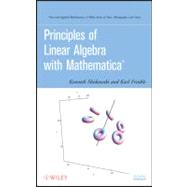- ISBN: 9780470637951 | 0470637951
- Cover: Hardcover
- Copyright: 8/2/2011
Principles of Linear Algebra with Mathematicar uniquely addresses the quickly growing intersection between subject theory and numerical computation. Computer algebra systems such as Mathematicar are becoming ever more powerful, useful, user friendly and readily available to the average student and professional, but thre are few books which currently cross this gap between linear algebra and Mathematicar. This book introduces algebra topics which can only be taught with the help of computer algebra systems, and the authors include all of the commands required to solve complex and computationally challenging linear algebra problems using Mathematicar. The book begins with an introduction to the commands and programming guidelines for working with Mathematicar. Next, the authors explore linear systems of equations and matrices, applications of linear systems and matrices, determinants, inverses, and Cramer's rule. Basic linear algebra topics, such as vectors, dot product, cross product, vector projection, are explored as well as the more advanced topics of rotations in space, rolling a circle along a curve, and the TNB Frame. Subsequent chapters feature coverage of linear programming, linear transformations from Rn to Rm, the geometry of linear and affine transformations, and least squares fits and pseudoinverses. Although computational in nature, the material is not presented in a simply theory-proof-problem format. Instead, all topics are explored in a reader-friendly and insightful way. The Mathematicar software is fully utilized to highlight the visual nature of the topic, as the book is complete with numerous graphics in two and three dimensions, animations, symbolic manipulations, numerical computations, and programming. Exercises are supplied in most chapters, and a related Web site houses Mathematicar code so readers can work through the provided examples.







